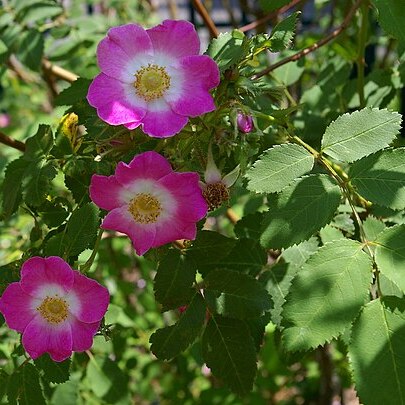Shrubs to 3 m tall. Branchlets terete, slightly curved, glabrous; prickles sparse to absent, straight or slightly curved, to 1 cm, stout, flat, evenly tapering to a broader base. Leaves including petiole 8–19 cm; stipules broad, mostly adnate to petiole, free parts auriculate, triangular-lanceolate, abaxially and at margin glandular, apex acuminate; rachis and petiole densely glandular-pubescent and sparsely shortly prickly; leaflets 5–9, ovate, elliptic, or broadly elliptic, 2.5–5.2 × 1.2–3 cm, abaxially pubescent and glandular, with prominent midvein and lateral veins, adaxially glabrous, base subrounded or broadly cuneate, margin doubly serrate, teeth often glandular apically, apex acute or rounded-obtuse. Flowers in lax corymb, 3.5–5 cm in diam.; pedicel 1.3–2.4 cm, glandular; bracts 2 or 3, ovate, abaxially reticulate, pubescent and glandular, margin irregularly serrate and glandular, apex acuminate. Hypanthium oblong or ovoid, densely stipitate glandular, glands to 2 mm. Sepals 5, ovate, leaflike, abaxially glandular, margin pinnately lobed or serrate, adaxially tomentose, teeth glandular apically, apex long caudate. Petals 5, pink or rose-purple, broadly obovate, abaxially slightly pubescent, base cuneate, apex emarginate. Styles free, slightly exserted, much shorter than stamens, pubescent. Hip deep red, oblong-ovoid, 1–2 cm in diam., with a neck at apex, glandular-pubescent or not, with persistent, erect sepals. Fl. May–Jul, fr. Jul–Oct.
More
A shrub. It grows 2.4 m high and spreads 1.5 m wide. It loses its leaves during the year. The stems are stout. The thorns are thick and well spaced. The leaves have an aroma when crushed. The flowers are single and in large clusters. They are pink. They have prominent yellow stamens. The fruit are long bristly red hips.
Can be grown by cuttings or seedlings. Seeds needs scarification.

